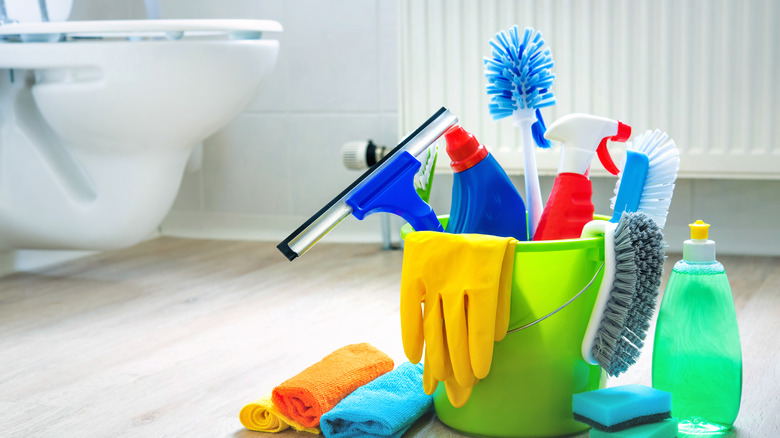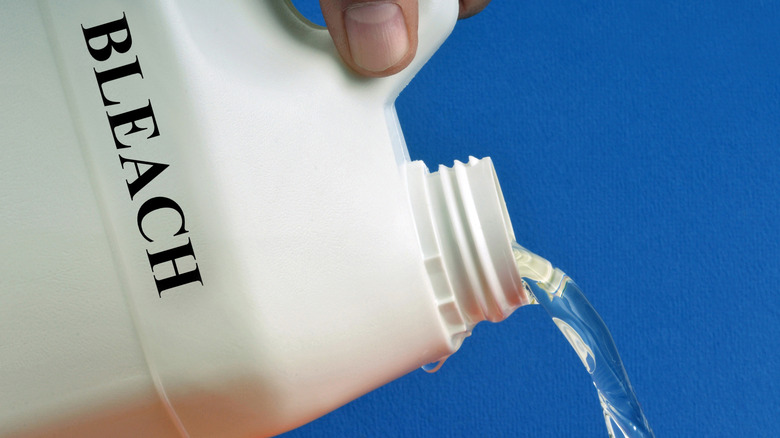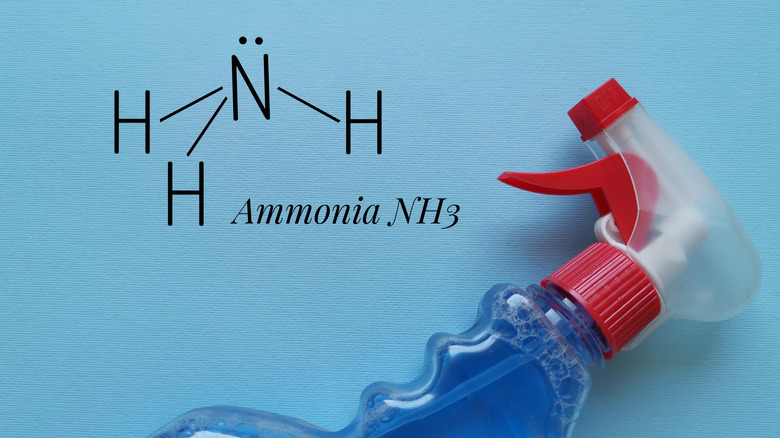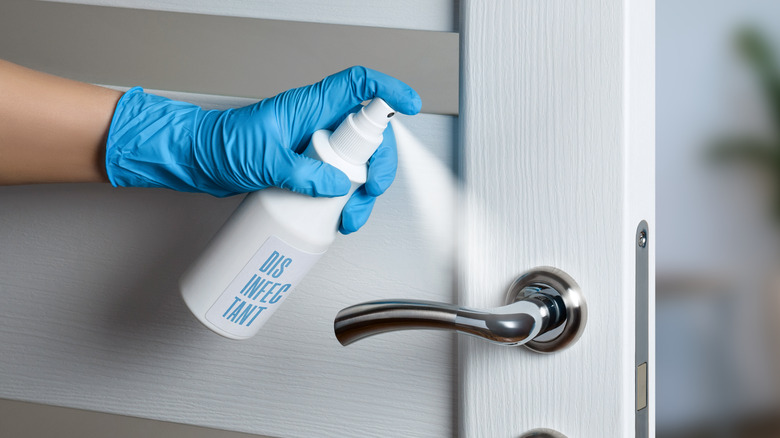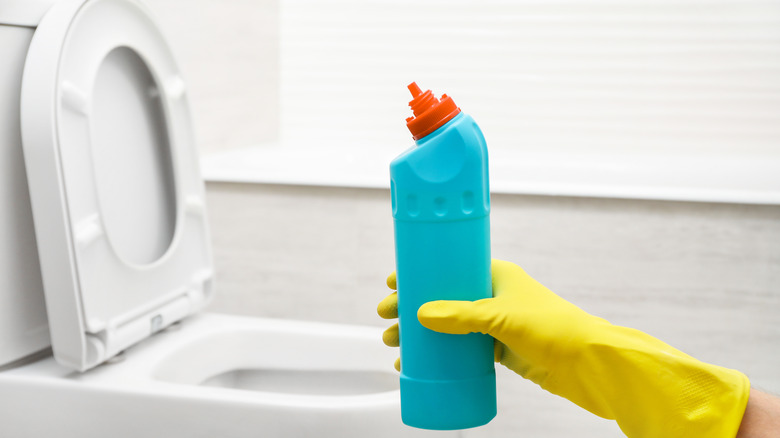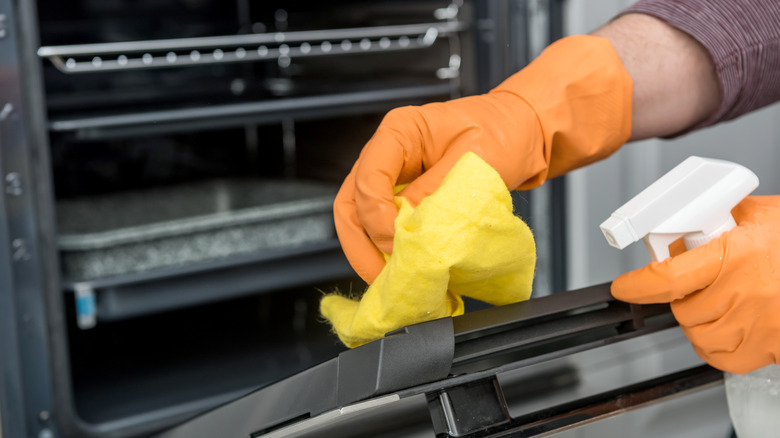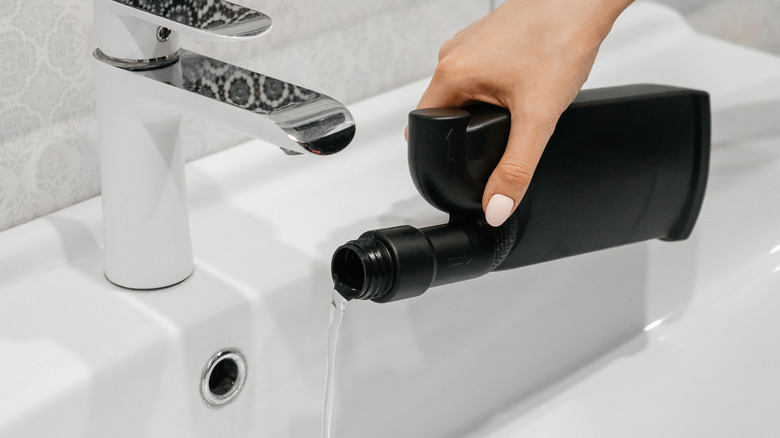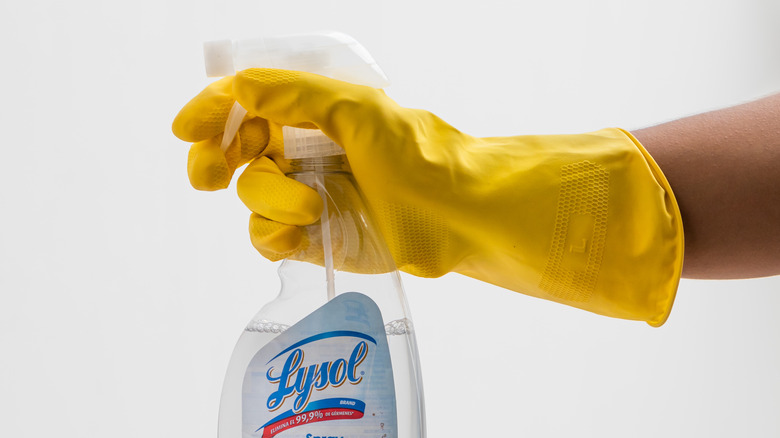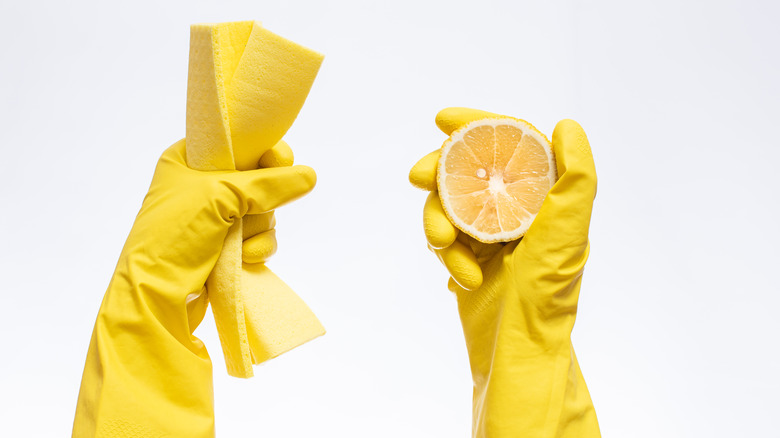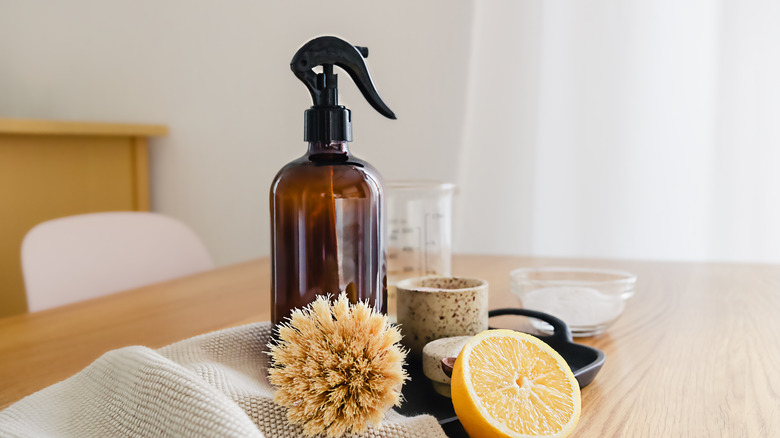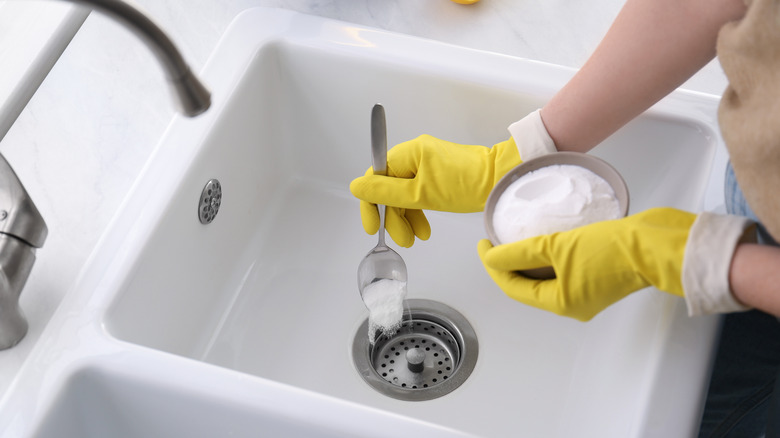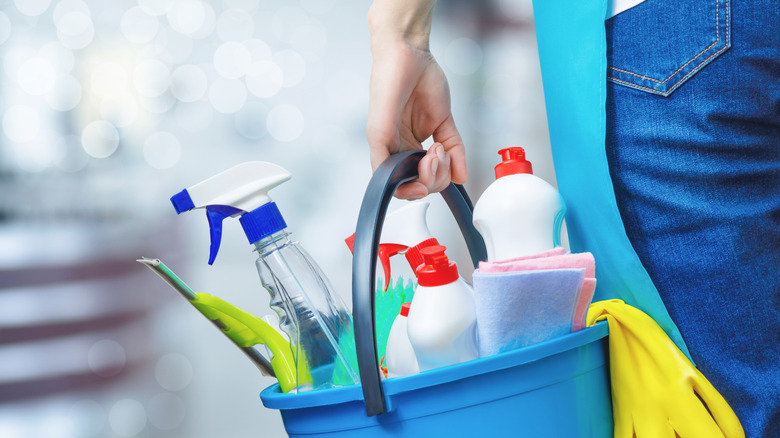Household Chemicals You Should Never Mix Together
We live in a chemical world! The air we breathe, the food we eat, and everything around us are made of chemicals, forever interacting and reacting with one another. Chemicals matter because everything made of matter consists of chemicals — and our houses are no exception. You can find chemicals in the clothes hanging in our wardrobes, the roof over our heads, the tables from which we eat, the paint on our walls, and the carpets on our floors. Yet mostly, you'll find them in a cupboard beneath the sink or safely locked away in a utility room. These household chemicals have a special place in the heart of the modern home because they're what we use to keep it as fresh as a daisy and free from germs.
As all cleaning zealots know, there's nothing quite like dancing around the house and getting trigger-happy with a bottle of bacteria-busting chemicals poised in one hand like a domestic gunslinger. A good cleaning blitz blows away the cobwebs and is good for the soul. However, while those special-strength household chemicals may be a staunch ally of filth-despising and germ-hunting crusaders everywhere, they must be treated with the utmost care. Even if your name is Walter White, there are certain household chemicals you should never mix because they can lead to serious injury and even death. Let's put our cleaning gloves on and find out more.
Bleach and vinegar
Bleach and vinegar are two giants in the cleaning world. Both have stood the test of time and proved their worth in the constant battle to keep our homes clean. Not only does it help remove grime, but it can also kill germs such as salmonella and E.coli, as per Bon Appetit. It's capable of cleaning everything from sinks and floors to greasy stovetops and pots and pans. Bleach has a reputation that speaks for itself. We've used it to clean and sanitize the most troublesome parts of our homes for decades. So surely mixing the two would prove to be a knockout partnership capable of achieving the deepest clean? Wrong!
ThoughtCo. reports that these two substances are dangerous when mixed. The sodium hypochlorite in bleach reacts with the acetic acid in vinegar to create chlorine gas. Every bit as deadly as it sounds, it was used as a chemical weapon by the Germans during World War I since it attacks the eyes, throat, and lungs and, in extreme cases, can cause death (via Healthline). While dangerous, accidentally mixing the two ingredients is common. In 2016, 35% of chlorine gas exposure cases were caused by combining cleaners (via the American Association of Poison Control Center).
Bleach and ammonia
Vinegar is not the only substance that's dangerous to mix with bleach. Ammonia is also another absolute no-go. Although you might think the chances of mixing bleach with ammonia are relatively rare, the devil is in the details. Ensure you read any product's ingredient list that you use alongside bleach. New York State Department of Health reports that ammonia is an extremely common chemical in the United States, and low concentrations of it can be found in many cleaning products. When you make the mistake of mixing bleach with products that contain ammonia, you're asking for a whole heap of trouble.
Healthline reports that when the two chemicals meet, it triggers a reaction that releases chloramine gas into the atmosphere. It depends on the amount of gas released and the length of exposure, but the symptoms of chloramine gas poisoning can range from eye irritation to chest pain to difficulty breathing. Although it is very rare, it can even cause coma and death in extreme cases. According to the Centers for Disease Control and Prevention (CDC), in the early 2020s, when everyone was cleaning their house more than usual due to the Covid-19 pandemic, there was a 20% increase in household cleaner poisoning cases. To be on the safe side, it's advisable never to mix bleach with any other cleaning product.
Bleach and rubbing alcohol
Most people are familiar with chloroform. It was famously used as an anesthetic to numb thousands of soldiers during the American Civil War as they underwent life-saving surgery, as per The History Press. Queen Victoria popularised it by using it when she was in labor, and during its long and controversial history, it has been used to treat everything from asthma to cholera. Yet it also has a sinister side. Chloroform's use as an anesthetic has been banned because it caused unexplained complications, and it has become notorious as the chemical agent used in many crimes. It's not the sort of compound you want hanging around the house or one you want to accidentally create by mixing bleach with rubbing alcohol.
Rubbing alcohol serves many purposes in the home. Medical News Today reports that it can be used for everything from disinfecting tick bites and counter to cleaning electronic appliances and jewelry. Yet mix it with bleach, and you create a potent and unpredictable substance — chloroform! The International Association for Chemical Safety reports that chloroform can cause everything from skin rashes, eye irritation, and respiratory distress to unconsciousness and severe organ damage. Chloroform is very easily absorbed through direct skin contact or breathing, so always ensure you keep your bleach and rubbing alcohol as far away from one another as possible.
Bleach and toilet bowl cleaner
Let's face it: There's no room for sloppiness or half-measures when you're blitzing the toilet bowl. Yet, although it may be tempting to throw the entire arsenal of household chemicals down the pan to remove any nastiness that may be stubbornly sticking around, you need to tread very carefully and ensure you never mix bleach and toilet bowl cleaner. Hunker reports that double dipping with cleaning products is never a good idea. A common error is using bleach as a reinforcement to help toilet cleaning products do their job. Big mistake!
The sodium hypochlorite in bleach will react with the acid in most toilet bowl cleaners to create the same toxic gas created when bleach is mixed with vinegar — chlorine! As we learned earlier, chlorine is a deadly substance that produces toxic fumes. No level of exposure to chlorine gas is safe within the home. Low levels can irritate the eyes and nose and trigger respiratory problems. High levels can cause vomiting, pneumonia, and death. If the worst happens and you accidentally mix bleach and toilet bowl cleaner, don't panic. Immediately stop cleaning, leave the room, and find a source of fresh air. Stay out of the room until all odors dissipate, and if you suffer from prolonged or severe symptoms, consult a medical professional.
Bleach and oven cleaner
Ovens are miraculous contraptions. Through a strange alchemy of heat regulation and timing, they can help create culinary delights. Yet all those roast chicken dinners and homemade Victoria sponges come at a price, which is a messy oven. Who hasn't opened their oven door one fine morning and sighed in despair at the slightly stale odors which greet them? Worse still, closer inspection reveals the once pristine interior is now caked with grime. It's time to clean the inside of that oven, particularly if you harbor high hopes of one day creating that elusive and perfect Yorkshire Pudding.
Yet be warned, although it may be tempting to go all in with bleach and oven cleaner, you could create a worse scenario than a dirty oven. Kitchn reports that you should not mix oven cleaner with bleach or products containing bleach. The sodium hypochlorite in bleach will mix with the acid found in most oven cleaners to create, you guessed it, chlorine. When you've got your head buried in an oven and you're frantically scrubbing as if your life depended upon it, the last thing you want to do is inhale this toxic gas in what is essentially a closed environment. Stay safe, and never mix chemicals when cleaning your oven!
Bleach and drain cleaner
The drains of our house take a daily battering. Everything flushed or washed down the sink ends up in the drains. It's no wonder they become easily blocked with tissues, hair, grease, food, and all the other debris of modern life. When a blockage occurs, the only thought on most people's minds is how to get rid of it and fast. In such desperate situations, throwing everything at the source of your domestic despair is tempting. Yet this can make a bad situation worse, as a young mom in Bristol, England, found out. Bristol Live reports that when Dominique Heath found her toilet blocked, she filled it with two bottles of drain cleaner.
When the clog didn't budge, Dominique emptied a 3-liter tub of bleach into the toilet and thought, "That should do it." Except it didn't. The sodium hypochlorite in the bleach mixed with the drain cleaner to release huge quantities of chlorine gas. Dominique explained, "I have never experienced fumes like it. My throat and eyes felt burned." Realizing she was suffering from a chemical reaction, Dominique shut the bathroom door and called emergency services. They ordered her to evacuate and entered the house in gas masks to wash away the chemicals. Dominque said, "We are all ok, but it was the dumbest thing I have ever done — please don't do this!"
Bleach and Lysol
Lysol is a cleaning brand that most shoppers are familiar with. According to The Sun, it was initially used to combat Germany's cholera epidemic in the late 1800s. By the time the Spanish flu pandemic hit in 1918, Lysol was being used to curb the spread of the virus via cleaning. Since then, Lysol's disinfectant spray has become a cleaning staple of many households. It claims to eliminate 99.9% of any bacteria, and its domestic effectiveness has been proven through the years. During the Covid-19 outbreak, its reputation for getting the job done saw a 70% sales hike as people looked to sanitize their houses. Like bleach, it is a tried and tested household cleaning product, but mix the two at your peril.
Home Oomph reports that Lysol products contain ammonia, so when you mix them with bleach, the reaction triggers chloramine gas. Other Lysol products also have ethanol as an ingredient, which creates chloroform when mixed with bleach. While there are Lysol products that do not contain ammonia or alcohol, it is always safe to assume that mixing anything with bleach or with Lysol is a no-go. Exposure to toxic chemicals can cause a slow onset of symptoms that are not readily recognizable as dangerous, such as a headache and dizziness. To avoid such a scenario, keep your bleach and Lysol separated.
Bleach and lemon juice
The humble lemon is something of a miracle fruit. According to Healthline, it is bursting at the seams with vitamin C and other nutritional goodness that help support a healthy body and mind. Studies have also shown that lemons can help lower cholesterol, reduce weight gain, prevent kidney stones from forming, and help reduce the risk of cancer. However, as Almanac points out, as well as being good for sore throats and upset stomachs, lemons are a godsend when keeping your house in tip-top condition. A little bit of lemon juice can help clean overs, scrub your bathroom, work wonders on discolored utensils, and can be used with a bit of salt to restore your old china's luster. Yet lemon juice doesn't work well when mixed with bleach.
The problem occurs when people accidentally use bleach with a citrus cleaner. CNN reports that such products contain lemons or orange peels which form a compound called limonene. A study by the American Chemical Society shows that a potentially dangerous gas is created when bleach combines with limonene. Although you can use bleach and citrus-based cleaners together in small doses, it's always advisable to do so in a heavily ventilated area.
Vinegar and hydrogen peroxide
Hydrogen peroxide is a hugely underrated ingredient in any pantry. As Kitchn points out, it can be used for everything from cleaning your oven to whitening your grout. While it's common knowledge that you shouldn't handle hydrogen peroxide without gloves or ingest it, did you know that you should never mix it with vinegar? Although it's ok to use one after the other on a counter, combining them both in a bottle creates a highly corrosive substance called peracetic acid that can wreak havoc with your health, particularly your lungs, eyes, throat, and skin.
Bulk Peroxide reports that a growing number of people are turning to natural ingredients such as vinegar and hydrogen peroxide for cleaning to lower their exposure to chemicals. Here's the rub. Because vinegar and hydrogen peroxide are hugely effective in getting the job done, many people think they'll create a superhero-style disinfectant if they combine them. Wrong! Although the resulting peracetic acid has widespread use as a heavyweight disinfectant in the food and medical industries, it has no place in the common home.
Vinegar and baking soda
There's usually a box of baking soda in the cupboard or fridge of everybody's house. The compound previously known as sodium bicarbonate has a multitude of uses, from helping clean the laundry to removing sweat stains, de-skunking your dog, unblocking sinks, and helping to absorb oil. And as you may recall from school science projects, when you mix baking soda with vinegar, things tend to snap, crackle, and pop! Yet, although baking soda and vinegar create an impressive chemistry together that is relatively harmless, you should never use this unique fizz and bubble solution to clean your house.
Moral Fibres reports that baking soda is a base, and when a base is mixed with acid — such as that found in vinegar — it creates a salty water solution that is PH-neutral. In other words, vinegar and baking soda neutralize the beneficial properties of one another to leave you with an ineffective solution of water, carbon dioxide, and salt. Obviously, this poses no significant health risk, but it leaves you with a solution that is nowhere near as potent as baking soda or vinegar on its own. Because of the fizz that the two make when combined, people mistakenly believe they are left with the Holy Grail of cleaning products. But it is just salty water.
Multiple cleaning products
As we mentioned in the introduction, we live in a chemical world, and the modern world has more bottled cleaning chemicals than you can shake a stick at. Here's where the real danger lies. Only the most clued-up and diligent chemist could reel off the exact ingredients in each cleaning product. For us laypeople, it's a guessing game in an endless minefield. In such a scenario, it's best to use caution and never mix multiple cleaning products. There's a solid reason why each cleaning product comes with a strongly worded warning never to mix with other chemicals.
As Enviro-Dri reports, different drain cleaner brands can contain different ingredients. If you mix two for whatever reason, they can create a chemical reaction that can lead to everything from severe skin burns to death. The same rules apply to kitchen cleaners, window cleaners, toilet cleaners, and everything else you use to keep your house looking fine and smelling sweet. If you cannot fix the problem with one specific product application, don't be tempted to go in with multiple products until the job is done. Your health is far more important than your house, and you'll live to clean another day by obeying the simple rule of never mixing multiple cleaning products.
